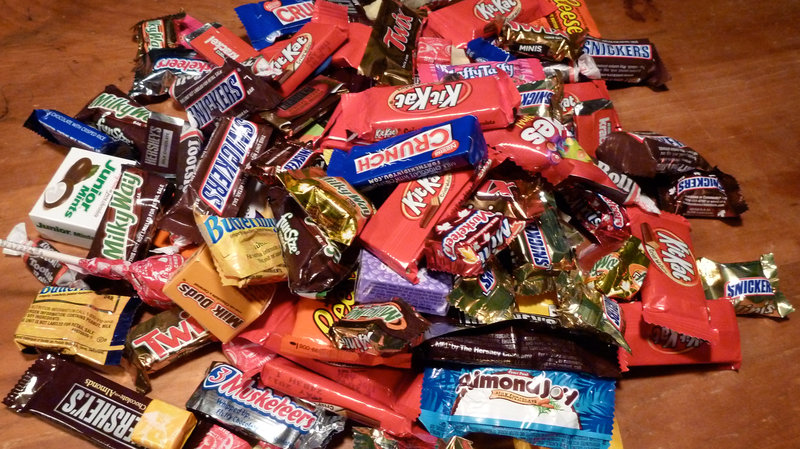Table of Contents
WHAT TO DO | TYPES | AMOUNT | SYMPTOMS | BROCHURES
When a dog eats chocolate it requires immediate attention. Dog chocolate poisoning symptoms appear in 1 to 4 hours. A chocolate dog poisonous emergency is caused by the canine toxin theobromine. Theobromine is a stimulant that is similar to caffeine. It is harmless to people, but can cause your dog to become very sick including problems with heart rhythm (arrhythmia), problems with the central nervous system, muscle tremors, seizures and coma. Other symptoms include diarrhea, vomiting, excessive urination and hyperactivity within hours or eating the chocolate.
The amount needed to cause toxicity is 100-200mg/kg with 250-500mg/kg being the amount where half of dogs could die. As rule of thumb, 4 oz. of milk chocolate has 240mg of theobromine. A 10 lb. dog would need to eat 2 to 3 milk chocolate bars to reach 240mg. Semi-sweet chocolate has 43% less theobromine. Baking chocolate has +73% more and can cause toxicity with only 1 oz (it has 450mg an oz, significantly above minimum toxic levels).
Treatment is needed immediately. It includes fluids, vomiting (if less than 2 hours after ingesting the chocolate), charcoal and possible medications that are normally prescribed for a racing heart and seizures. Call your veterinarian immediately.

What to do about Dogs and Chocolate
Call your veterinarian and describe the type of chocolate he or she might of ate (dark, unsweetened, milk chocolate, semi-sweet), the amount and the time. Also, give your veterinarian or emergency veterinary center the weight of your dog. Describe any symptoms that you are seeing.
If it has been within two hours since your dog ate the chocolate, your veterinarian will give your dog a medication to induce vomiting. After 2 hours it will have passed through the stomach and into the small intestine where it will all be absorbed by the body. At that point, inducing vomiting will not rid your dog of the toxin followed by repeated doses of activated charcoal to absorb any toxins.
If your dog eats chocolate and shows signs of toxicity, he may need to be hospitalized for a time so that he can be observed and supportive therapy given for any symptoms he has. For instance, if he is having seizures, anti-convulsive medication will be given. The length of the hospitalization will depend on how much chocolate he ate, what symptoms he is showing, and the severity of the symptoms. Usually he will be kept until the theobromine has left his system. Theobromine has a half life of 7 ½ hours. That means that in 7 ½ hours from the time your dog eats chocolate, half the theobromine will have left his system. In another 7 ½ hours, half of that will be gone, and so on. Symptoms can last up to 72 hours.
Your veterinarian will use charcoal to absorb the toxin and possibly induce vomiting. Intravenous fluids may be administered to help clear the toxins from the bloodstream. Any symptoms will also be treated. The key is to undergo treatment before the toxins enter the blood.

Types of Chocolate and Dogs
Different types of chocolate have different amounts of theobromine. Therefore they reach a toxic level at different amounts. Toxicity depends on the amount eaten and the body weight of your dog.
Dogs and Chocolate Types |
|
|---|---|
|
Type |
Amount |
| Milk Chocolate | 45 mg theobromine per ounce (1 ounce = approximately 1 square). It is toxic at one ounce eaten per pound body weight. |
| Semi-sweet chocolate | 150 mg - 260 mg per ounce. It becomes toxic at one ounce eaten per 3 - 6 pounds body weight. |
| Cocoa beans | 450 - 1500 mg per ounce. They become toxic at one ounce eaten per 10 - 33 pounds body weight. |
Chocolate in any dose is not good for your dog including human junk food such as chocolate cookies. White chocolate, carob and cocoa butter do not contain dangerous toxins.
Example of Dog Poisonous Amounts of Chocolate
Chocolate starts to be toxic to dogs at levels indicated below. Remember that this table is for unsweetened chocolate, for milk chocolate a dog can tolerate approximately 10x the amount without severe symptoms.
Unsweetened Chocolate |
||
|---|---|---|
|
Dog Weight In Pounds |
Chocolate Squares |
Ounces Of Chocolate |
|
20 |
1 |
1 |
|
40 |
2 |
2 |
|
80 |
4 |
4 |
For example if your 80 pound dog eats half a chocolate cake she will probably experience diarrhea and vomiting.
Potential toxic doses in a 44 pound dog are:
|
Type Of Chocolate |
Amount |
|---|---|
|
Unsweetened Cocoa |
3oz |
|
Baking Chocolate |
5oz |
| Semisweet Chocolate | 7oz |
|
Milk Chocolate |
20oz |

Can a Dog Eat White Chocolate?
Your dog can eat white chocolate and cocoa butter since both have a very small amount of theobromine. Hot chocolate is also not dangerous with approximately 12mg of theobromine per serving.
Dog Chocolate Symptoms
If your dog eats chocolate in lower doses, digestive upset such as vomiting and diarrhea may occur. This can happen immediately or may even happen the next day.
In higher doses, more severe symptoms will occur. You dog may appear restless and irritable. He may have increased urination. His heart rate will increase. He might have tremors or even seizures. At toxic levels, coma or even death can result. If your dog has eaten close to the amounts of chocolate listed above, you need to take him to the veterinarian right away. If you dog eats a little chocolate common symptoms are:
- Vomiting
- Diarrhea
- Pancreatitis (inflammation of the pancreas)
- Tremors
- Increased thirst
- Weakness
- Balance problems
- Hyperexcitability
Dogs that eat a large amount of chocolate can experience more severe symptoms:
- Heart arrhythmia/abnormal rhythm
- Seizures
- Coma
- Muscle Spasms
For Additional Reading:
References
Brevitz, Betsy DVM
Hound Health Handbook
The Doctors Book of Home Remedies for Dogs and Cats
Prevention Magazine
Toxicants Associated with Stimulation or Seizures
Beasley, V.
The Merck/Merial Manual for Pet Health
